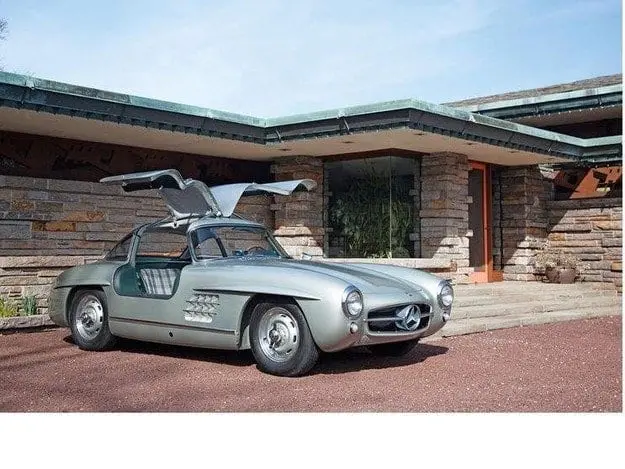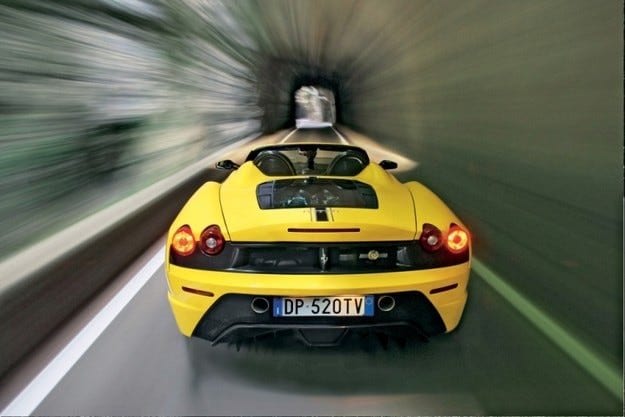
Test drive Mercedes-Benz 300 SL and Max Hoffman's villa

A car and an architectural masterpiece, whose fates are closely intertwined
Max Hoffman was a strong man. So strong that he made it Mercedes start mass production of the 300 SL, from which, as an importer in the USA, he made a good profit. And he invested money, including in an expensive house.
How was it in New York in 1955 in a social class where men wore light summer suits and met in clubs? For example. Max Hoffman: "Dear Mr. Wright, your project for my house is a real dream." Frank Lloyd Wright: “Thank you dear Mr. Hoffman, thank you very much. But it will be pricey if you know what I mean.” “I don’t see any problems, things are going well for me. But banknotes, as you know, are a transient thing. Will you allow me to offer you a Mercedes 300 SL and a limousine 300? " "Why not?" The gentlemen are smiling, the rings in their glasses and the bourbon splashes in the tah.
Frank Lloyd Wright builds a dream villa
Be that as it may, in any case, in 1954 the life of the Austrian immigrant Max Hoffman was in full swing. On February 6, a successful importer of European car brands saw the presentation of the Mercedes 300 SL at the New York Auto Show, which he created at his insistence and continues to replenish his treasury. And his villa, designed by star architect Frank Lloyd Wright, was nearing completion. Lloyd rarely built private homes, but his design was for the Guggenheim Museum, whose circular array solidified the architect's reputation. As for luxury cars, then 88-year-old Wright always had a special relationship with them, so the above dialogue is probably not far from reality.
Now the 300 1955 SL rustles across the shingle of the alley and dislodges the patinated "pagoda" from its place under the canopy. There is no garage - converted into a guest apartment. Scott moves 280 SL; is the person who manages the property of the Tisch family, the current owners of the house. Several times Scott excitedly called his boss and enthusiastically announced a great sports car that was filmed here. He then sends greetings to the millionaire. By the way, the owner of our SL, probably, also does not work in a kiosk in neighboring Manhattan. Or maybe he's doing something in the industry, who knows.
Not entirely original? So what?
Anyway, he had service technicians remove the chrome bumpers on his winged SL and install a wooden steering wheel from that time on. It can't be smashed like the original, so gymnastic skills are needed to get out of the car. In the semi-open atrium, the curves of the aluminum body shine in the sun and are sharply dissonant with the rectangular geometry of the one-story house. The years of construction only begin to show in detail as you discover worn light switches, built-in furniture and signs of attempted upgrades. However, at first glance, it seems that the builders celebrated the construction of the roof just a few months ago. However, in this elite area, the fun must end at 17:XNUMX, because after that, no host should disturb the acoustic and visual peace with their dirty van - this will be taken care of by the security service.
Inline six with frequent metal snoring
The 300 SL is due out soon, far from the most discreet, and the heart beats from its silencer. Its tubular lattice frame, which was particularly light and strong, but required a lift-door solution, still gives off that incredible feeling that came with the world premiere of the SL in 1954. Probably, there is currently no direct injection of gasoline or dry sump lubricant, and even more so the dynamic performance can delight motorists. But even the frequent metal snoring of the six-cylinder unit, set at an angle below 40 degrees, makes us feel the uncompromising of this car.
Up to 6600 rpm, the 8,55:1 compression ratio unit lets out a triumphant scream, and once thrilled test riders with a burst of thrust occurring at 4500 rpm. Even today, the sports coupe starts up vigorously and wants to quickly shift into the next gear, but there are not many gear ratios - only four.
The 300 SL is hard to drive, easy to sell
The Mercedes 300 SL feels lighter than it actually is (over 1,3 tons) – at least until you have to stop or turn. However, even in the US, these maneuvers cannot be avoided, and then the person behind the wheel gets hot - driving an SL is quite a challenge.
But the SL sold easily - and in 1954, and in 1957, when the roadster appeared. Hoffman expanded his car empire, and the people at Mercedes didn't beg much when he asked them for an SL for the masses - and started producing the 190 SL. And now our 300 SL is slowly moving along the badly patched roads still called with impunity the Highway. Worn brakes require predictable driving – this has been the case in the past, and another reason, let's call it, is too fast on the road.
Sudden rear end pitch at higher cornering speeds has only been overcome by Mercedes in the roadster, which has a one-piece oscillating axle with a lower center of rotation. “However, it is not recommended, as most sports riders are accustomed to the way they ride their weaker motorcycles, to enter a corner too quickly and cause skidding on the rear axle. Then the SL can suddenly submit, in which case it is very difficult to react,” warns Heinz-Ulrich Wieselmann in motorsport 21/1955. So it was then, in 1955. And Frank Lloyd Wright hardly made such attempts.
technical details
Mercedes Benz 300 SL (W198)
EngineWater-cooled XNUMX-cylinder in-line engine, overhead valves, single overhead camshaft, timing chain, injection pump, dry sump lubrication
Working volume: 2996 cm³
Bore x Stroke: 85 x 88mm
Power: 215 hp at 5800 rpm
Maximum. torque: 274 Nm @ 4900 rpm
Compression ratio 8,55: 1.
Power transmissionRear-wheel drive, single plate dry clutch, fully synchronized four-speed transmission. The main transmission options are 3,64, 3,42 or 3,25.
Body and chassisBase frame made of steel grid with light sheet steel body (29 pieces with aluminum body)
Front: independent suspension with a pair of crossbars on each wheel, coil springs, telescopic shock absorbers.
Rear: Single-lever swing axle with coil springs, telescopic shock absorbers
Dimensions and weight Length x width x height: 4465 x 1790 x 1300 mm
Wheelbase: 2400 mm
Front / rear track: 1385/1435 mm
Weight: 1310 kg
Dynamic performance and costMaximum speed: 228 km / h
Acceleration from 0 to 100 km / h: about 9 seconds
Consumption: 16,7 l / 100 km.
Period for production and circulationHere 1954 to 1957, 1400 copies, Roadster from 1957 to 1963, 1858 copies.
Text: Jens Drale
Photo: Daniel Byrne

